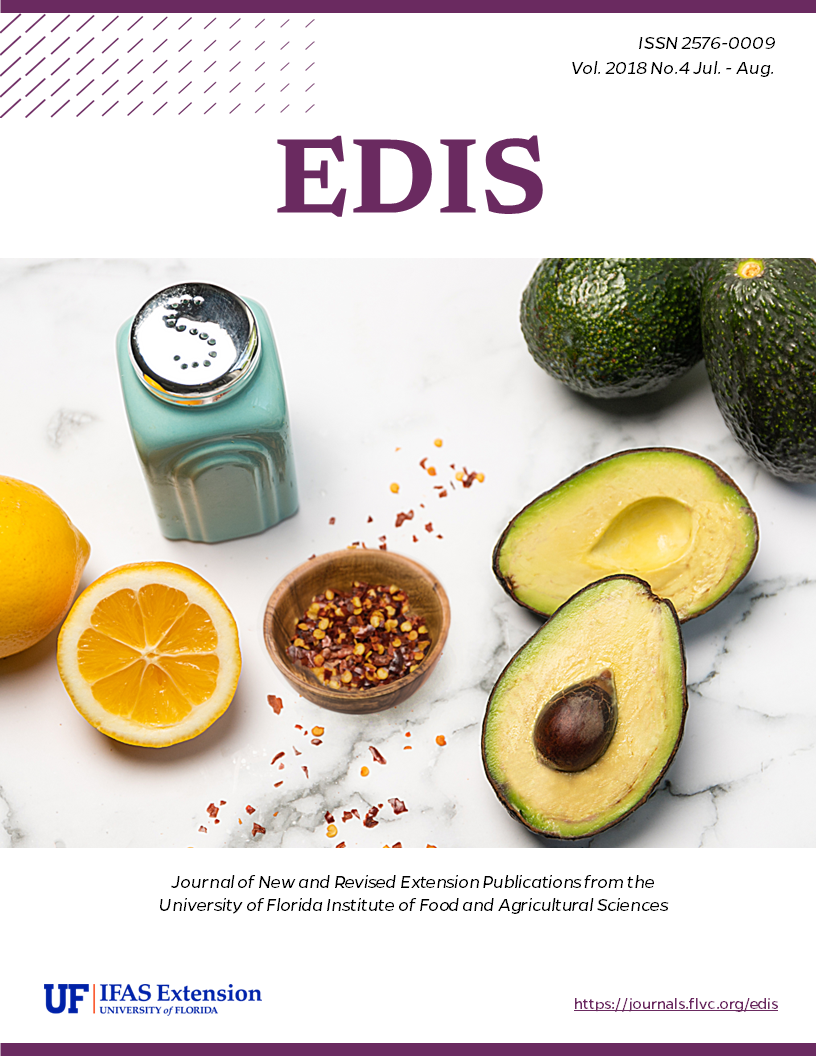Abstract
The pale damsel bug, Nabis capsiformis (Germar), one of the most widespread Nabis species, is a generalist predator that can be found in open areas, including coastal habitats (Lattin 1989). It is commonly reported throughout the southeastern United States, in a variety of ecosystems, it is particularly common in field and row crop agroecosystems. All nympal and adult life stages of Nabis capsiformis are excellent predators and can typically eat one lepidopteran egg or aphid per day when small and as many as two dozen eggs or other prey as later instars and adults. They can survive for up to two weeks without food and become cannibalistic if other prey are unavailable. They use their thickened raptorial front legs that are lined with spines to catch and hold prey, then suck out the body contents with their piercing mouthparts.
Damsel bugs, including the pale damsel bug, are so named because of the way they hold their front legs up, as though they were lifting a skirt hem to curtsey. At first glance, they appear like a cross between a mantis and an assassin bug. Includes: Introduction - Distribution - Description - Host Plants - Life Cycle - Importance - Selected References.
https://edis.ifas.ufl.edu/in1210
Also published at: https://entomology.ifas.ufl.edu/creatures/VEG/pale_damsel_bug.html
References
Ashby JW. 1974. "A study of arthropod predation of Pieris rapae L. using serological and exclusion techniques." Journal of Applied Ecology 11: 419-425. https://doi.org/10.2307/2402195
Braman SK, Yeargan KV. 1990. "Phenology and abundance of Nabis americoferus, N. roseipennis, and N. rufusculus (Hemiptera: Nabidae) and their parasitoids in alfalfa and soybean." Journal of Economic Entomology 83: 823-830. https://doi.org/10.1093/jee/83.3.823
Buschman LL, Whitcomb WH, Hemenway RC, Mays DL, Ru N, Leppla NC, Smittle BJ. 1977. "Predators of velvetbean caterpillar eggs in Florida soybeans." Environmental Entomology 6: 403-407. https://doi.org/10.1093/ee/6.3.403
Cornelis M, Quirán E, Coscarón MC. 2012. "Description of some immature stages of Nabis (Tropiconabis) capsiformis (Hemiptera: Nabidae)." Revista Mexicana de Biodiversidad 83: 1009-1012.
Deitz LL, Van Duyn JW, Bradley Jr JR, Rabb RL, Brooks WM, Stinner RE. 1976. "A guide to the identification and biology of soybean arthropods in North Carolina." North Carolina Agricultural Experiment Station Technical Bulletin 238: 1-264.
Dinkins RL, Brazzel JR, Wilson CA. 1970. "Seasonal incidence of major predaceous arthropods in Mississippi cotton fields." Journal of Economic Entomology 63: 814-817. https://doi.org/10.1093/jee/63.3.814
Godfrey KE, Whitcomb WH, Stimac JL. 1989. "Arthropod predators of velvetbean caterpillar, Anticarsia gemmatalis Hübner (Lepidoptera: Noctuidae), eggs and larvae." Environmental Entomology 18: 118-123. https://doi.org/10.1093/ee/18.1.118
Guppy JC. 1986. "Bionomics of the damsel bug, Nabis americoferus Carayon (Hemiptera: Nabidae), a predator of the alfalfa blotch leafminer (Diptera: Agromyzidae)." The Canadian Entomologist 118: 745-751. https://doi.org/10.4039/Ent118745-8
Harris HM. 1931. "Nabidae from the State of Parana." Annales Musei Zoologici Polonici 9: 179-185.
Hormchan P, Schuster MF, Hepner LW. 1976. "Biology of Tropiconabis capsiformis." Annals of the Entomological Society of America 69: 1016-1018. https://doi.org/10.1093/aesa/69.6.1016
Jessep CT. 1964. "A note on the feeding habits of Nabis capsiformis Germar." New Zealand Entomologist 3: 23. https://doi.org/10.1080/00779962.1964.9722826
Kerzhner IM. 1983. "Airborne Nabis capsiformis (Heteroptera: Nabidae) from the Atlantic, Indian and Pacific Oceans." International Journal of Entomology 25: 273-275.
Kerzhner IM, Henry TJ. 2008. "Three new species, notes and new records of poorly known species, and an updated checklist for the North American Nabidae (Hemiptera: Heteroptera)." Proceedings of the Entomological Society of Washington 110: 988-1011. https://doi.org/10.4289/0013-8797-110.4.988
Krey KL, Blubaugh CK, Chapman EG, Lynch CA, Snyder GB, Jensen AS, Fu Z, Prischmann-Voldseth DA, Harwood JD, Snyder WE. 2017. "Generalist predators consume spider mites despite the presence of alternative prey." Biological Control 115: 157-164. https://doi.org/10.1016/j.biocontrol.2017.10.007
Lattin JD. 1989. "Bionomics of the Nabidae." Annual Review of Entomology 34: 383-400. https://doi.org/10.1146/annurev.en.34.010189.002123
Miliczky ER, Horton DR. 2005. "Densities of beneficial arthropods within pear and apple orchards affected by distance from adjacent native habitat and association of natural enemies with extra-orchard host plants." Biological Control 33: 249-259. https://doi.org/10.1016/j.biocontrol.2005.03.002
Ojeda-Peña D. 1971. "Biologia y hábitos de Nabis capsiformis Germar (Hemip.: Nabidae)." Sociedad Entomológica de Perú 14: 297-303.
Pericart J. 1987. "Hémiptères Nabidae d'Europe occidentale et du Maghreb." Faune of France 71: 1-169.
Pitre HN, Hillhouse TL, Donahoe MC, Kinard HC. 1978. Beneficial arthropods on soybeans and cotton in different ecosystems in Mississippi. Mississippi Agricultural & Forestry Experiment Station 90: 1-9.
Rebolledo R, Villegas G, Klein C, Aguilera A. 2005. "Fluctuación poblacional, capacidad depredadora y longevidad de Nabis punctipennis Blanchard (Hemiptera: Nabidae)." Agricultura Técnica (Chile) 65: 442-446. https://doi.org/10.4067/S0365-28072005000400010
Samson PR, Blood PRB. 1980. "Voracity and searching ability of Chrysopa signata (Neuroptera: Chrysopidae), Micromus tasmaniae (Neuroptera: Hemerobiidae), and Tropiconabis capsiformis (Hemiptera: Nabidae)." Australian Journal of Zoology 28: 575-580. https://doi.org/10.1071/ZO9800575
Scharff RF. 1912. Distribution and origin of life in America. New York, NY: Macmillan. 497 pp. https://doi.org/10.5962/bhl.title.29129
Shepard M, Carner GR, Turnipseed SG. 1974. "Seasonal abundance of predaceous arthropods in soybeans." Environmental Entomology 3: 985-988. https://doi.org/10.1093/ee/3.6.985
Stehlik J. 1970. "Contribution to the knowledge of Heteroptera of Moravia and Slovakia." Acta Musei Moraviae 55: 209-232.
Unless otherwise specified, articles published in the EDIS journal after January 1, 2024 are licensed under a Creative Commons Attribution-NonCommercial-NoDerivs 4.0 International (CC BY-NC-ND 4.0) license.

